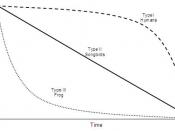Human Population Survivorship of
19th & 21st Centuries in Winston Salem, North Carolina
Teague, Jimmie
Bio 302W-Sec 02
Dr. Stavn
March 24, 2014
INTRODUCTION
Demographical studies are essential when looking at the survivorship of a species and factors that could change aspects of the population dynamics. These factors include periods of war, environmental changes, disease evolution, to economic factors, and improvements in medical science. Comparing the survivorship of populations from different time periods will help researchers see the trends that could be affecting the population. This type of comparison is accomplished by using life tables and survivorship graphs. Life tables are statistical relationships relating life expectancy and mortality for a given group. This specified group is defined as a cohort, which is a group of individuals born in the same time period. Life tables come in two forms. The first form is the cohort or dynamic life table that looks at a group born during the same time interval.
The second form is the static or time-specific life table it is not as commonly used because it counts all individuals alive at a given time and records the age of each. Typically, the static table is used when the group being measured has a long life span that may not be conducive for following over time. When analyzing the population in question over several time periods, it is important to construct a dynamic-composite table that allows the data to be collected at the age of death and over a specified time interval (Stavn, 2013). This data is gathered in order to establish a cohort in order to create life tables and survivorship curve comparison by time, age, and sex. There are three types of survivorship curves, each of which look at a population in a different way. In this experiment,


